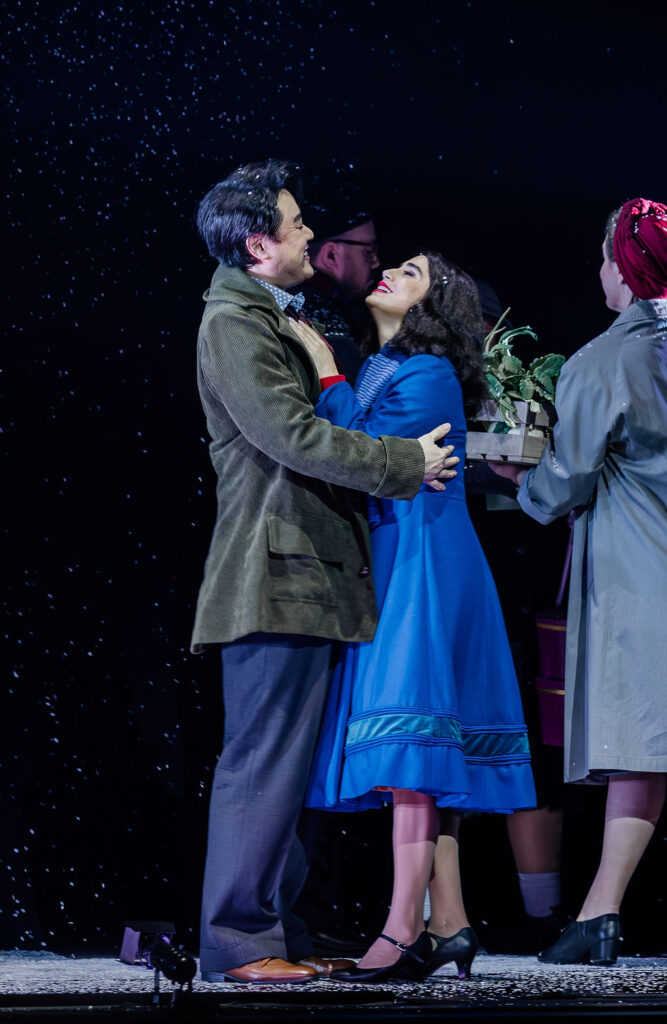 Elena Perroni as Mimi and Ji-Min Park as Rodolfo
Elena Perroni as Mimi and Ji-Min Park as Rodolfo
Photographer; Andi Crown
Giacomo PUCCINI – La Boheme (Opera in Four Acts)
Libretto by Luigi Ilica and Giuseppe Giacosa
Cast: Ji-Min Park (Rodolfo)
Elena Perroni (Mimi)
Samuel Dundas (Marcello)
Emma Pearson (Musetta)
Benson Wilson (Schaunard)
Hadleigh Adams (Colline)
Robert Tucker (Benoit/Alcindoro)
Chris McRae (Parpignol)
Joseph Haddow (Sergeant)
The Freemasons Foundation NZ Opera Chorus
Te Whanganui-a-Tara Children’s Voices
Chorus Director: Michael Vinten
Orchestra Wellington
Conductor: Dionysis Grammenos
Director: Bruno Ravella
Set Designer: Tiziano Santi
Costume Designer: Gabrielle Dalton
Lighting Designer Paul Jackson
St.James Theatre, Wellington
Wednesday, June 18th, 2025
I was interested to read in the splendid programme provided by New Zealand Opera for this production of “La Boheme” the director’s notes, headed by a paragraph in which appeared the statement containing the words “making La Boheme anew”. Having been by turns intrigued, delighted and dispirited over my years of going to opera by different directorial decision-making regarding production outcomes, I wondered to what extent the director here, Bruno Ravella, was planning to “refresh” the work’s familiar scenarios, characterisations and outcomes to a point where “La Boheme” might no longer be recognisable as such! I needn’t have worried, as it turned out – though the setting here was designed to reflect an immediately post-World War Two ambience, the story remained in Paris, and the opera’s essential theme – the fragility of youthful relationships – emerged via the cast’s interactions with their director as whole-heartedly and with as much sweetness, volatility and vulnerability as it ever has.
Act One opened depicting the garret in which four young artists lived, the set conveying as much bohemian ambience as one would expect, its dimensions framed by huge canvasses and an enormous skylight – I did think some of the furniture set back too far (the stove, for example) on a voluminous stage, distancing us at first from the various characters as they made their gradual appearances and revealed their personalities. Ji-Min Park’s Rodolfo and Samuel Dundas’s Marcello made an engaging pair, playing off one another throughout interactions such as their burning of the “drama” in the stove, all the while their vocal tones “colouring in” for us their sympathies and differences. They were ably complemented by Hadleigh Adams’ Colline and Benson Wilson’s Schaunard, and with each of the four voices benefitting from movement towards the front-of-stage, particularly with the “landlord-asks-for-rent” episode, and a hilariously pathetic characterisation of the unfortunate Benoit, here, by Robert Tucker. Though Wilson’s Schaunard and Adams’ Colline didn’t project the full amplitudes of their fellow Bohemians, their ensemble during the landlord’s gulling and eventual ejection by the resourceful tenants had all the energy and humour required.
The entrance of Mimi (Elena Perroni) completely altered the ambient trajectories of the story – which took place after the Bohemians apart from Rodolfo had gone out to celebrate Christmas Eve with the ill-gotten gains of the rent money, while Rodolfo, with an article to finish for his newspaper, had stayed behind. A knock at the door, and a neighbour, a beautiful, pale-faced young girl dressed in blue appeared, asking Rodolfo for a light for her candle. Perroni’s voice was at first tremulous and faint, but upon finding she had somehow dropped her key and anxiously coming forwards, the tones suddenly blossomed and filled the spaces, as it did gloriously in her aria “Mi Chiamano Mimi” (though appreciative applause greeted Park’s earlier “Che gelida manina” the offstage banter of the Bohemians with their ”hurry up” calls broke into the spell created by Perroni’s equally ardent efforts and gave the audience no time to respond!). But an atmospheric touch was the appearance of the snowflakes descending from the dark all around the departing lovers at the act’s end.
The Momus’s Café scene opened with its traditionally swinging gusto, the crowd-choruses placed well forward and voices projecting strongly, though seemingly light on numbers, This was in part made up for by designer Gabrielle Dalton’s eye for “period” among the crowd’s general dress-code, from which Chris MacRae’s Parpignol and his followers, the children, were differentiated with “threads and patches” – the truly amazing voices and characterisations of the Wellington Children’s Chorus members delighted with their energies and vocal clarities! Amid the merriment Marcello’s quick anger at the sound of his ex-girlfriend Musetta’s voice was tellingly conveyed, even if I didn’t think the surtitles needed to be vulgarised as much as they were in places by way of indelicate comments regarding Musetta’s moral character – this was supposedly 1947 and not 1974!
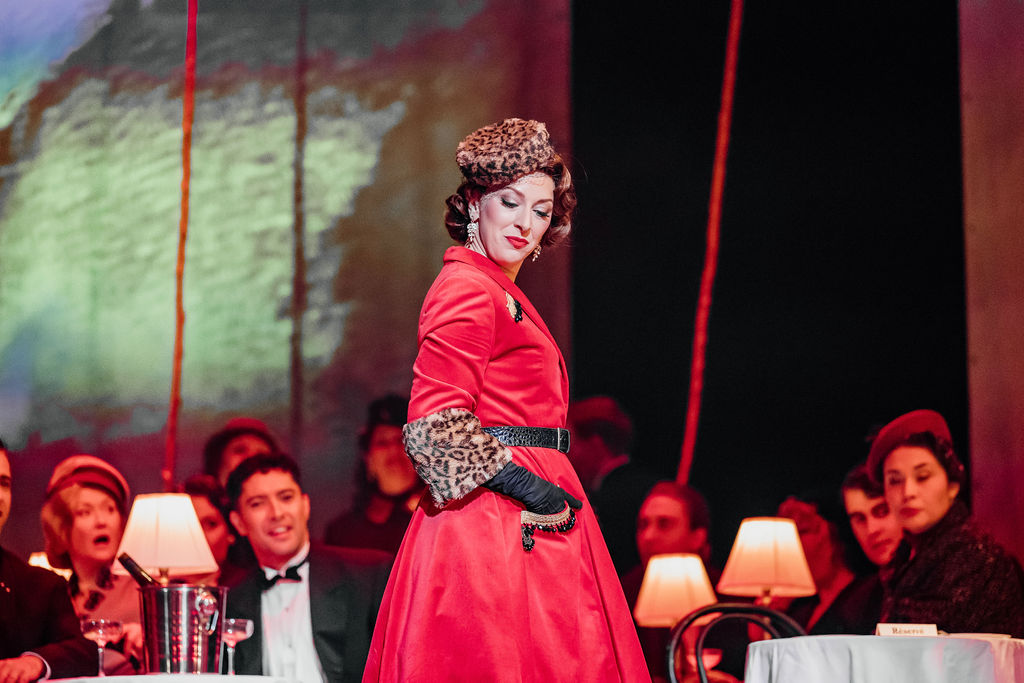 Emma Pearson as Musetta
Emma Pearson as Musetta
Photographer: Andi Crown
I thought Park’s and Dundas’s voices came increasingly into focus here, Park’s tenor gradually clearing its slightly splintered first-act tones, and ringing out more truly to my ears, as did Dundas’s Marcello similarly gain in authority in response to his flighty sweetheart Musetta’s appearance. Emma Pearson’s Musetta was a show-stealer, ably reinforced by her manner, her eye-catching crimsonly-drenched costume and the pathetically-wrought attentions of her “sugar daddy” Alcindoro (Robert Tucker again, after a quick change from the hapless landlord’s attire!). From the moment of her entrance onwards, it was her “scene”, her voice by turns playfully “kittenish” and redolent with longing. Her deportment on the lowered swing became the centre of everyone’s attention, as were her antics with the shoe to break her former lover Marcello’s resistance, and win back his affections. And with an almost Mahlerian touch – the arrival of a military band on stage, playing with superb swagger and ceremony – the act marched to its picturesque end!
The most intense of the Opera’s four acts is the third, set in the dead of winter, in bleak surroundings and with a mere handful of participants, underlining the desolation of the scene and its bitter-sweet human tragedy. Cameo appearances by a guard-soldier checking people’s papers reinforced the sense of winter’s oppression, as the opera’s four principal characters met variously, conveyed their purpose and then withdrew to “winter out” the cold. Marcello and Musetta spent the time quarrelling, as Mimi and Rodolfo heartbreakingly decided they could no longer live together and would go their different ways, but not until spring’s arrival. We relished every moment of Musetta’s flirtatious behaviour and Marcello’s jealousy, while feeling both Rodolfo’s and Mimi’s initial despair at the latter’s failing health and eventual acceptance of their destinies, a scenario of contrasts beautifully judged by the composer and characterised here most ambiently by the singers and players. In particular, Ji-Min Park’s Rodolfo and Elena Perroni’s Mimi together gave us phrases and tones in places such as “Vuoi che aspettiam, la primavera ancor?” (Shall we wait until spring comes again). that in the opera’s time-honoured ways touched our hearts.
The finale returned us to Act One’s bohemian garrett, with what seemed almost like déjà vu – Rodolfo and Marcello both at work, but thinking and singing about their respective loves in absentia. A “here before” feeling was heightened when the other two Bohemians arrived, again provoking horseplay and high spirits, until Musetta’s sudden arrival with an obviously ailing Mimi put everybody into earnest, if quietly-despairing emergency mode, leaving Rodolfo and Mimi alone together reminiscing about their past life and voicing dreams of possible continuance. The friends returned with touching accoutrements, including a muff for Mimi’s hands – but all too late! Without the music the scenario would have seemed unbearably contrived and sentimental, but Puccini’s music worked its usual magic and brought the usual oceanic breakers of emotion to the moment of the hapless heroine’s passing and the resulting consternation of those all around her.
Over three of the four acts I couldn’t fault the settings and their ambiences – a tribute to the visionary deportments of structure and detail on the part of designer Tiziano Santi, and in close conjunction with the lighting skills of Paul Jackson. Act Two started and finished resplendently, though I missed the sheer unbuttoned festivity remembered from other production’s crowds in the opening coming-and-going scenes – and towards the end the bastions of Café Momus for me didn’t quite lift from the ground with the impact of Musetta’s Waltz song’s climax as I’ve previously experienced; still, those superb young chorus voices and the military band provided enough complementary swagger to give the scene its own distinction. I came away from the production, however, with the sounds of those voices of the opera’s four principals in Act Three stuck in my memory, superbly conjured up by conductor Dionysis Grammenos and his Wellington Orchestra players, everything passionately emoting through the contrasting bleakness – the music forging with the city’s wintry desolation an unforgettably poignant partnership.
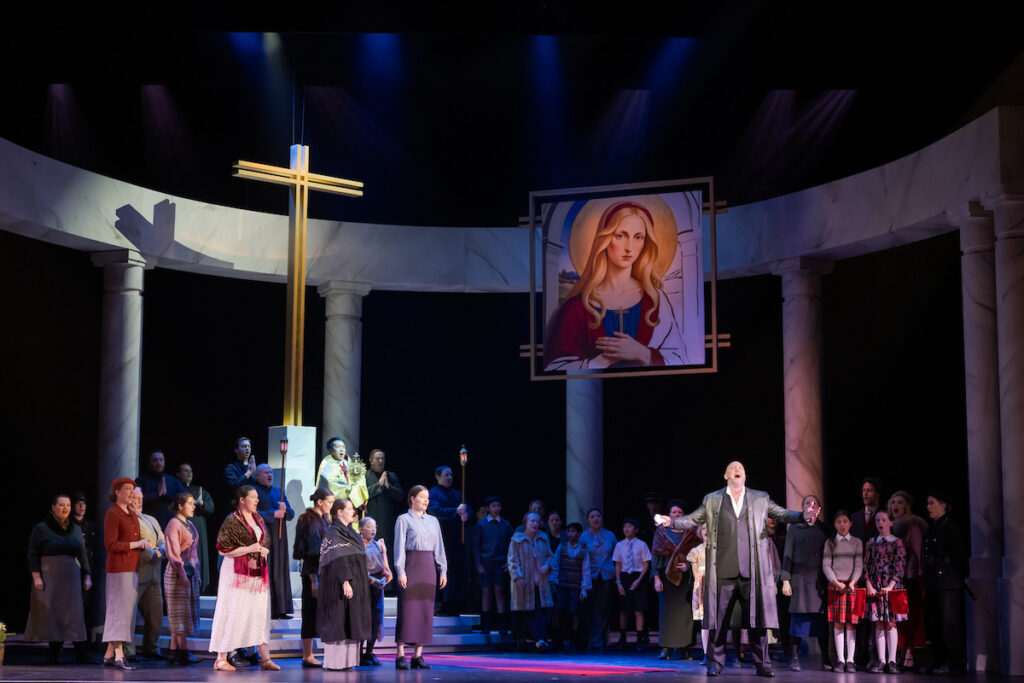
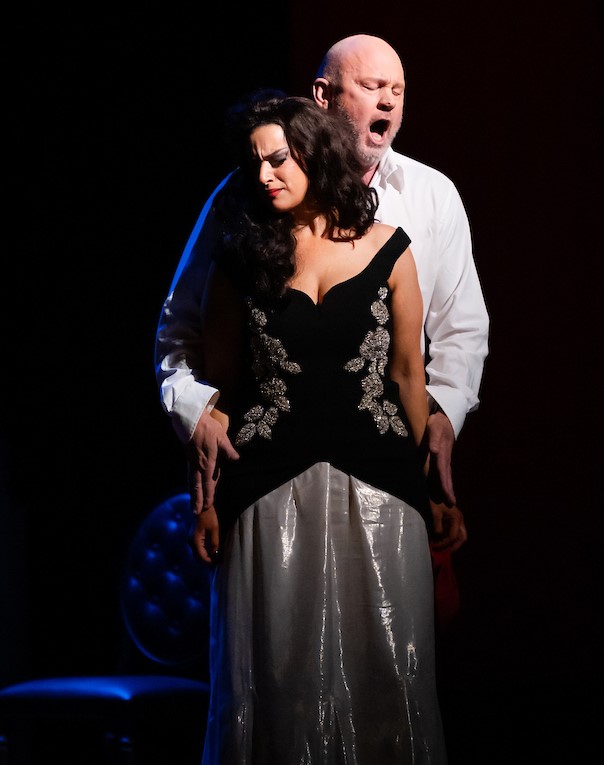
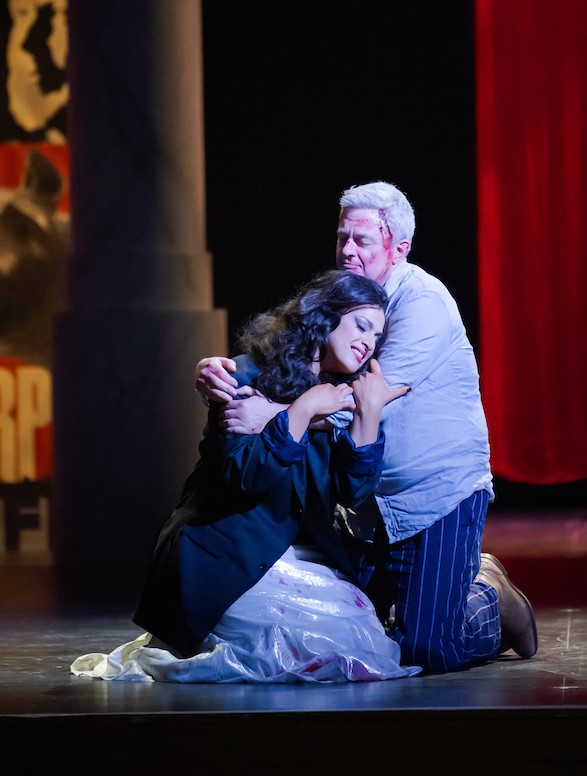
 Act One: Wade Kernot (Coach), Manase Latu (Count Ory), Moses MacKay (Raimbaud), NZ Opera Chorus – photo credit: Lewis Ferris
Act One: Wade Kernot (Coach), Manase Latu (Count Ory), Moses MacKay (Raimbaud), NZ Opera Chorus – photo credit: Lewis Ferris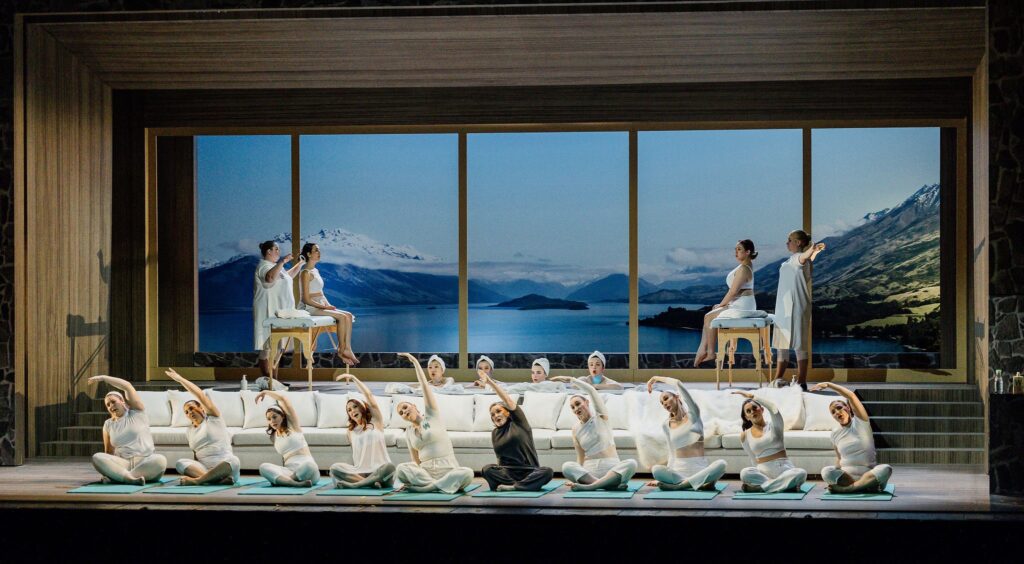 Le Comte Ory – Act Two (beginning) – NZ Opera Chorus, with Emma Pearson (Countess Adele), Tayla Alexander (Alice) and Andrea Creighton (Ragonde)
Le Comte Ory – Act Two (beginning) – NZ Opera Chorus, with Emma Pearson (Countess Adele), Tayla Alexander (Alice) and Andrea Creighton (Ragonde)